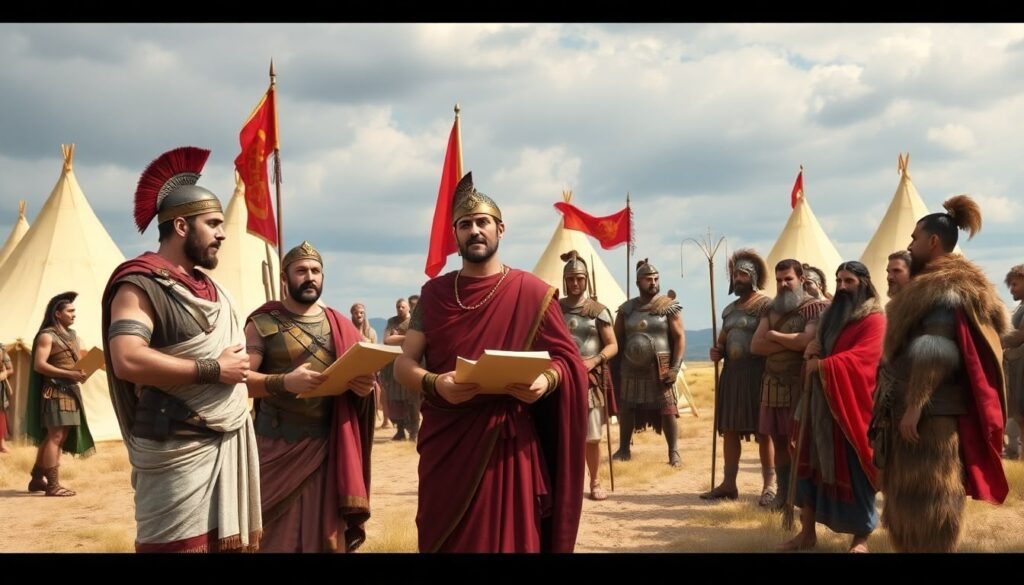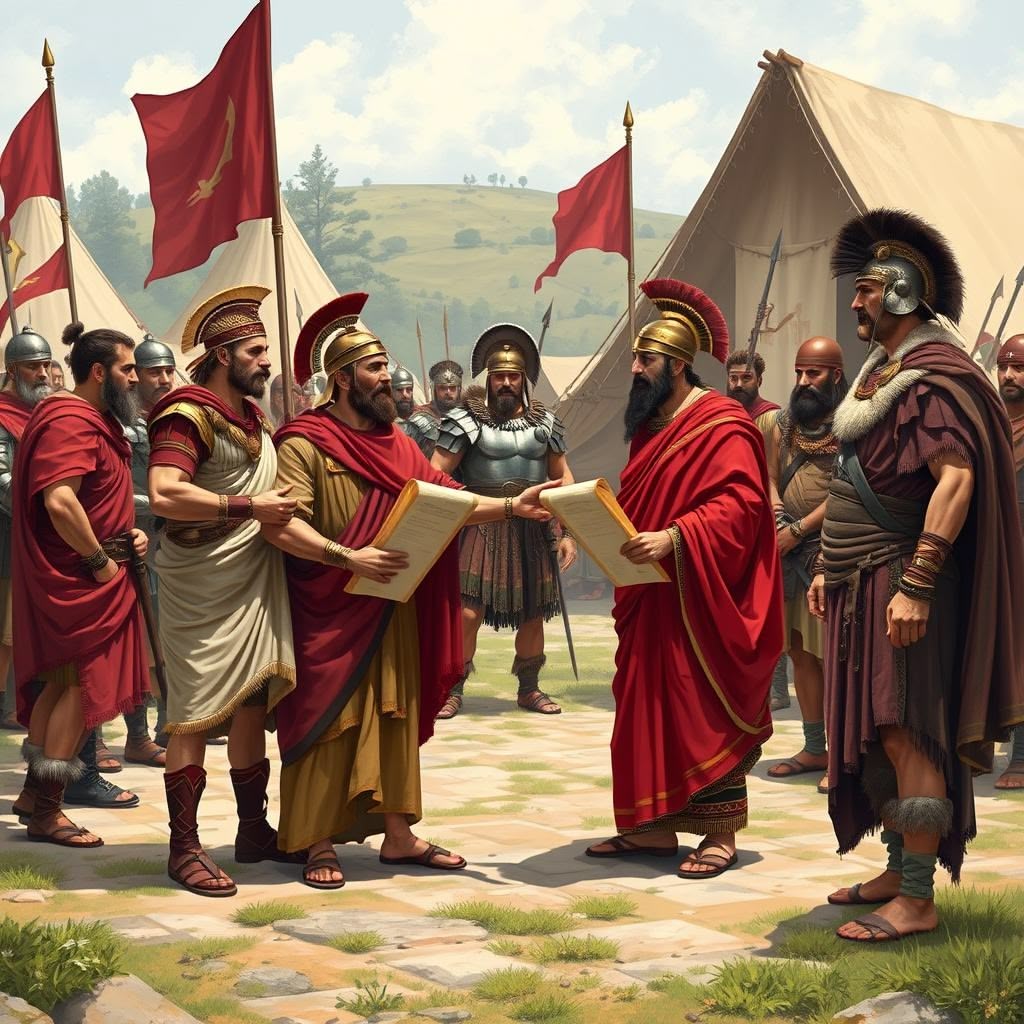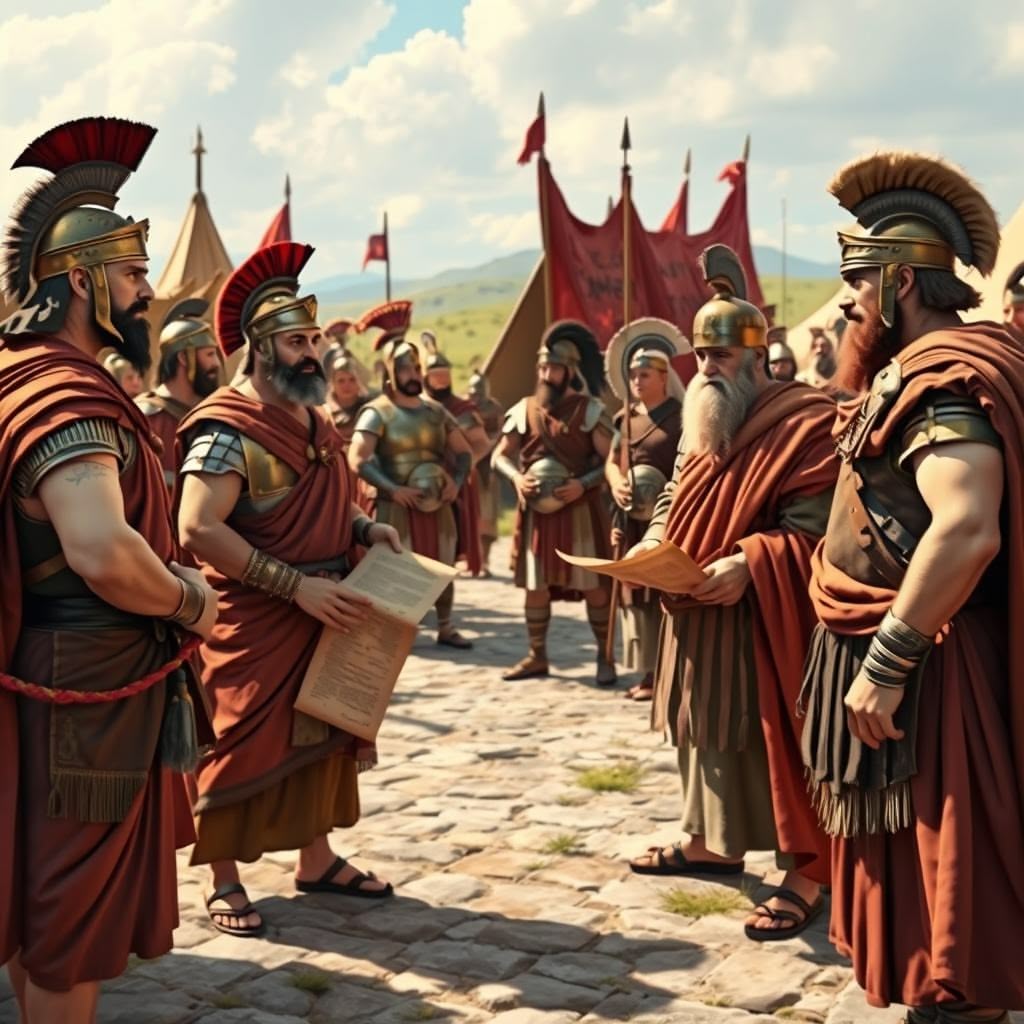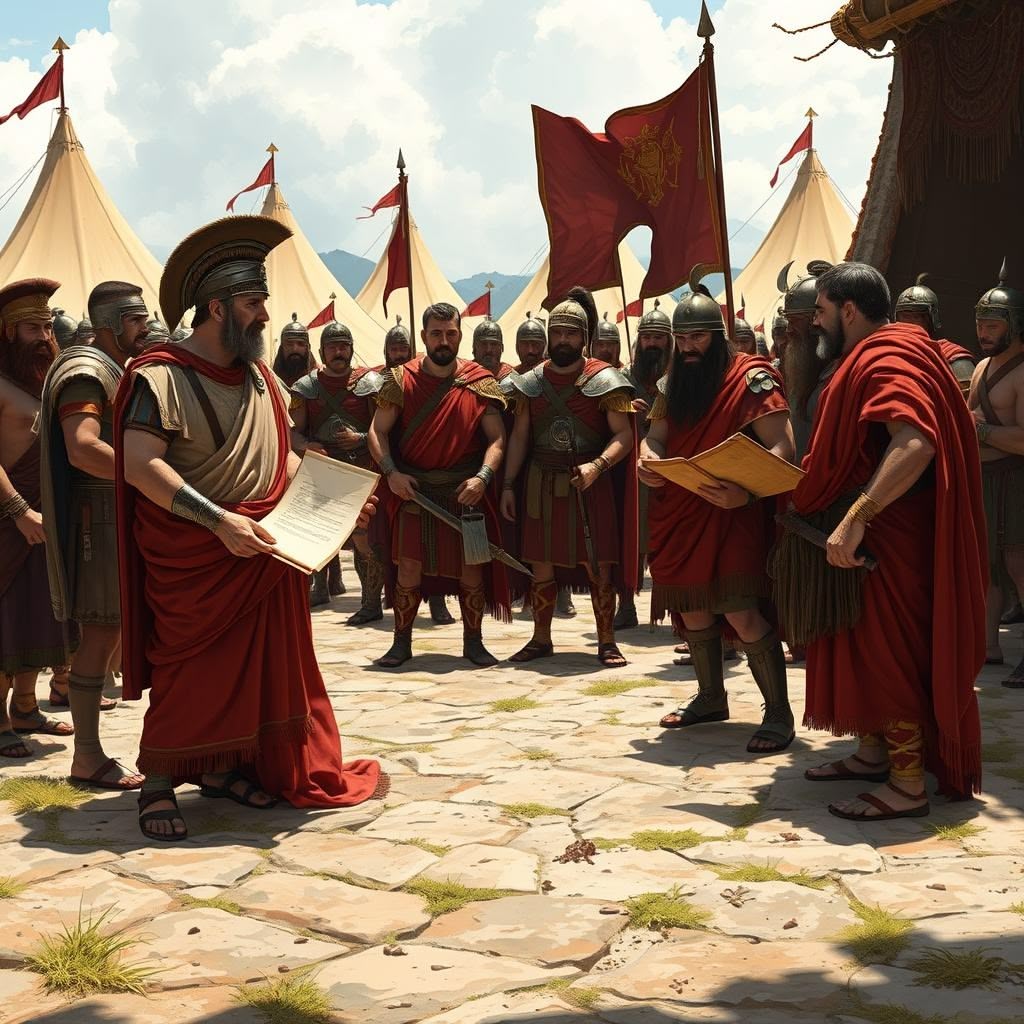Roman diplomacy tactics with barbarians reveal a complex interplay between friendship and subjugation. Rome did not simply conquer and destroy neighboring communities; instead, it often incorporated them into a system of alliances that balanced cooperation with control. This approach allowed Rome to extend its influence while maintaining relative stability among diverse peoples.
Key elements of Roman diplomacy included:
- Establishing formal alliances rather than outright annexation.
- Offering protection and shared spoils of war to allied groups.
- Imposing terms that ensured Roman dominance in political and military matters.
This delicate balance created a relationship that was neither purely amicable nor entirely oppressive. Communities labeled as “barbarians” were often treated as valuable partners, yet their autonomy was limited by Rome’s overarching authority. The Roman strategy blended pragmatic interests with diplomatic finesse, ensuring loyalty while reinforcing supremacy.
Understanding this mix of friendship and subjugation is essential to grasp how Rome managed to build a vast network of allies that supported its military campaigns and territorial expansion. The following sections explore the mechanisms behind these alliances and their significance in Roman history.
The tactics used in these diplomatic relations were deeply intertwined with the legal and political frameworks established during the Roman Republic. This period marked a significant transition in governance from monarchy to a complex political structure, laying the foundation for modern democracies.
Moreover, the Twelve Tables, created between 451-450 BCE, played a crucial role in shaping Roman law and legal history. These laws were the first attempt to codify the complex legal practices of ancient Rome, which in turn influenced the diplomatic strategies employed by the state.
However, it is important to note that these strategies were not solely about control or dominance. They also involved a certain degree of partnership and cooperation. The relationship between Rome and its allies often reflected this balance. Despite being labeled as “barbarians”, these communities were treated as valuable partners while their autonomy was limited by Rome’s overarching authority.
This blend of pragmatic interests with diplomatic finesse is what allowed Rome to maintain loyalty among its allies while reinforcing its supremacy. Understanding this interplay is essential to grasp how Rome managed to build a vast network of allies that supported its military campaigns and territorial expansion.
Lastly, it’s worth exploring the social dynamics within Rome itself, particularly concerning the legal status of women. The intricate legal framework surrounding Roman women significantly influenced gender dynamics in ancient Rome, highlighting how citizenship was intrinsically linked to relationships with men.
The Socii System of Alliances
The socii system, a cornerstone of Roman diplomacy, played a crucial role in expanding Roman influence and maintaining control over conquered territories. Here is an in-depth look at the significance of the socii alliances and their historical origins:
1. Detailed Explanation of the Socii System
The socii alliances were a strategic diplomatic arrangement where Rome entered into agreements with various Italian communities. These alliances were not equal partnerships but rather hierarchical relationships where the allied communities were subordinated to Roman authority.
Under this system, Rome could leverage the military resources and manpower of its allies while maintaining overall control and dominance in foreign policy decisions.
2. Historical Origins with Foedus Cassianum
The roots of the socii system can be traced back to early treaties such as the Foedus Cassianum, established in 493 BCE with the Latin League. This treaty marked the beginning of Rome’s practice of forming alliances with defeated communities instead of outright annexation or destruction.
Through the Foedus Cassianum and subsequent agreements, Rome laid the foundation for a network of allies that would contribute significantly to its military might and territorial expansion.
By understanding the evolution and dynamics of the socii system, we can appreciate how Rome effectively integrated conquered peoples into its sphere of influence while reinforcing its position as the dominant power in the region. This integration was not just limited to political and military aspects; it also extended to cultural and religious domains as explored in our resource on Ancient Roman Religion. Moreover, these alliances facilitated infrastructure development, including Roman Roads, which served as vital arteries for trade and military movement. The architectural prowess of Rome, evident in Roman Architecture, further solidified its dominance. For more insights into Ancient Rome’s fascinating history and culture, visit Men of Pompeii.

Bilateral Treaties and Alliance Network
Roman diplomacy relied heavily on the formation of bilateral treaties with various Italian communities beyond the initial socii system. These treaties were not uniform; each reflected specific local circumstances, negotiated terms, and mutual obligations. The process involved Rome establishing formal agreements directly with individual communities rather than through collective or multilateral pacts. This approach allowed Rome to tailor alliances to meet strategic needs while gradually weaving a dense alliance network across the Italian peninsula.
Key features of these bilateral treaties included:
- Mutual defense obligations: Allied states were required to support Rome militarily when called upon. This often meant providing troops, sometimes in significant numbers, to supplement Roman legions.
- Military integration without loss of autonomy: Allies retained their own governments and laws but committed resources and manpower to Rome’s campaigns.
- No tribute payments: Instead of taxation, allied communities contributed by furnishing soldiers, weapons, and occasionally leadership officers drawn from their ranks.
- Security guarantees: Rome assured the protection of allied territories from external aggression as well as internal threats from rival allies or rebellious factions.
The strength of this alliance network lay in its flexibility and scalability. As new communities entered into bilateral treaties with Rome, they became nodes within an expanding web that enhanced Rome’s regional dominance while distributing military responsibilities broadly. These alliances made it possible for Rome to mobilize vast armies rapidly, composed not only of Roman citizens but also large contingents from allied states.
Obligations under these treaties could be strict:
- Allies had to supply troops promptly during wartime.
- They had to equip their forces according to agreed standards.
- Failure to meet obligations risked punitive measures or renegotiation under less favorable terms.
This system ensured Rome’s military campaigns were well-supported without overburdening its citizenry. It also reinforced loyalty through a reciprocal relationship: allies gained security and shared spoils while recognizing Roman supremacy in foreign affairs and military command.
In this way, the bilateral treaty system functioned as a cornerstone of Roman diplomacy — expanding influence through calculated partnerships bound by clear expectations and mutual benefit embedded within an overarching structure dominated by Rome. The success of these military strategies was deeply intertwined with Roman mythology, which shaped societal norms and political aspirations, as well as the popular perception of figures like gladiators who were both admired for their combat skills yet victimized within a complex social system, reflecting the duality of gladiatorial life in ancient Rome.

Loyalty, Pragmatism, and Shared Spoils Among Allies
Loyalty within the Roman alliance system was not simply a product of goodwill or cultural affinity. It was built on tangible benefits and pragmatic concerns that made allegiance to Rome a rational choice for many allied communities. Understanding Roman Diplomacy Tactics with Barbarians—Friendship or Subjugation? means recognizing how these factors worked together to sustain Rome’s dominant network.
Factors Fostering Loyalty
- Shared Spoils of War: Allies were often rewarded with a share of the spoils from military campaigns. This included land, wealth, and slaves captured during conquests, which incentivized cooperation and made the alliance economically attractive.
- Security Guarantees: Rome’s protection against external enemies provided a strong motive for loyalty. Allied states could rely on Roman military strength to deter or repel rival powers or hostile tribes.
- Autonomy Within Limits: Although subordinated to Rome’s overall control, allies maintained their local governments and laws. This partial autonomy helped reduce resentment and encouraged compliance without direct Roman administration.
Pragmatic Motivations
Alliances with Rome were driven by practical considerations rather than emotional bonds or shared identity. Many communities joined the Roman network because:
- Military Protection: Aligning with Rome offered a shield from more aggressive neighbors or rival barbarian groups who might otherwise threaten their survival.
- Economic Opportunity: Participation in Rome’s expansive wars opened avenues for wealth accumulation through plunder and territorial gains.
- Political Stability: Being part of Rome’s alliance system provided internal stability by linking local rulers to a powerful hegemon capable of enforcing order.
Rome’s diplomacy carefully balanced friendship expressed through mutual benefits and obligations with clear signs of subjugation, ensuring allies remained dependent yet invested in the system’s success. This pragmatic approach allowed Rome to weave a durable fabric of loyalty among disparate peoples, transforming former enemies into cooperative partners under Roman dominance.
Understanding this intricate web of alliances also requires an exploration into the daily life in ancient Rome, which was vastly different for various social classes, especially the patricians and plebeians. The patricians, known as masters of Roman luxury and power, played a significant role in shaping these alliances due to their wealth and influence. Meanwhile, the art and culture in ancient Rome also reflect the societal structure and values during this period, further enriching our understanding of this historical context.

Friendship, Subjugation, and Dominance in Treaty Terms
The dynamic between friendship and subjugation played a crucial role in Roman diplomacy tactics with barbarians, shaping the power dynamics and long-term stability of alliances. This nuanced approach to diplomacy exemplified the complexity of Roman foreign policy and its strategic manipulation of power dynamics for long-term imperial success.
1. Friendship vs. Subjugation
Friendship in Roman diplomacy was not merely about camaraderie but rather a strategic tool to maintain control over allies while presenting a facade of mutual respect. It involved offering protection, trade opportunities, and shared spoils of war to incentivize loyalty.
On the other hand, subjugation underscored Rome’s dominance in treaty terms. It imposed conditions that favored Roman interests, ensuring that allies adhered to Roman foreign policy and military directives. This hierarchical structure maintained Rome’s position as the dominant force in the alliance network.
2. Dominance through Treaty Terms
Rome’s dominance in treaty terms was evident in the unequal power dynamics established through diplomatic agreements. Treaties outlined specific obligations for allies, such as providing military support, acknowledging Roman authority, and refraining from forming alliances with Rome’s enemies.
These terms not only secured Rome’s military advantage but also solidified its political influence over allied states. By controlling the terms of engagement and decision-making processes, Rome effectively maintained its supremacy within the alliance system.
The balance between friendship and subjugation allowed Rome to expand its territorial control while ensuring a semblance of stability among its allies. This strategy is reminiscent of Scipio Africanus during the Second Punic War when he defeated Hannibal, establishing Rome’s dominance over Carthage.
Furthermore, the legacy of ancient Rome continues to shape Western civilization today (Men of Pompeii). The principles of Roman law, which originated around 753 BCE, are still relevant in various legal systems today.
Understanding the lives of plebeians, who represented the majority and significantly influenced the development of political and economic structures in ancient Rome, is essential for grasping the social dynamics of that era. Additionally, exploring the transition from monarchy to a republican system during the birth of the Roman Republic provides valuable insights into the complexities of Roman governance and its enduring impact on modern political structures.

Military Success, Territorial Expansion, and Large Armies Through Alliances
The Roman Republic’s military success and territorial expansion were intricately linked to its strategic use of alliances across Italy. This section delves into the pivotal role played by alliances in Rome’s dominance and growth:
1. Crucial Role of Alliances
- Alliances were fundamental to Rome’s military victories, providing crucial support in battles and campaigns.
- Through alliances, Rome could leverage the strengths and resources of various communities to bolster its own military capabilities.
2. Territorial Expansion
- Rome’s alliance system facilitated the gradual annexation of territories and the integration of new regions into its growing empire.
- By forging alliances with neighboring communities, Rome could secure control over key strategic locations and expand its influence across Italy.
3. Mobilization of Large Armies
- Alliances enabled Rome to mobilize vast armies composed not only of Roman legions but also allied troops.
- These large armies, comprising both Roman and allied forces, provided the manpower necessary for extensive military campaigns and territorial conquests.
4. Strategic Advantage
- The ability to call upon allied forces significantly enhanced Rome’s military capacity and flexibility.
- By consolidating alliances, Rome could project power over a wider geographical area, ensuring dominance in conflicts and deterring potential adversaries.
5. Consolidation of Power
- Through successful military engagements supported by alliances, Rome solidified its control over newly acquired territories.
- The combination of military prowess and strategic alliances laid the foundation for Rome’s territorial expansion and consolidation of power in Italy.
In essence, alliances were not merely diplomatic arrangements but strategic assets that underpinned Rome’s military success, territorial growth, and eventual hegemony in the ancient world.
Beyond these aspects of governance and warfare, entertainment in Ancient Rome played a crucial role in shaping social relationships and political authority. The spectacle of gladiators, chariot races, and theatrical performances captivated the populace while simultaneously influencing societal norms.
Moreover, agriculture was another vital sector during this period. It wasn’t just about food production; agriculture served as a crucial driver for Rome’s economic growth and social development. The wealth generated from agricultural activities significantly contributed to funding military campaigns and expanding territorial boundaries.
The story of Ancient Rome is not merely one of conquest and expansion; it’s also a tale of innovation, culture, governance, and exploration that has left an indelible mark on the world. The influence of Roman law continues to be felt today as seen in the enduring impact of the Corpus Juris Civilis on modern legal systems.
Conclusion
Roman diplomacy tactics with barbarians showcased a complex interplay between friendship and subjugation. This dual approach was not merely about conquest but about creating a sustainable system of control and cooperation that enhanced Roman influence across Italy.
Key takeaways include:
Friendship as a diplomatic tool: Alliances offered protection, shared spoils, and political inclusion, which fostered loyalty among allied communities. This sense of partnership, however pragmatic, helped maintain relative stability among subjects.
Subjugation as a foundation of power: Rome’s dominance in treaty terms ensured control over foreign policy and military obligations. Allies were integrated into Rome’s strategic framework without equal status, reflecting a clear hierarchy.
Balanced strategy for expansion: The blend of cooperation and control allowed Rome to build large armies and expand territorially without constant rebellion or collapse of the alliance network.
This nuanced approach highlights why Roman diplomacy was effective—not because it relied on pure friendship or sheer domination alone, but through a carefully calibrated mix that secured loyalty while asserting Roman supremacy. The legacy of these tactics offers valuable insights into managing diverse populations under a dominant power, emphasizing that influence often requires both incentives and firm boundaries.
Moreover, the philosophical underpinnings of Roman thought, such as those derived from Stoicism, also played a significant role in shaping these diplomatic strategies. Stoicism emphasized reason and virtue, principles that likely influenced the way Romans approached their relationships with both allies and subjugated peoples.

